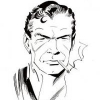Unquestionably so, but one must bear in mind that it was a mere 17 years after the end of World War II, and hostilities with the Japanese. As you say, Red China was not a concern until the latter part of the Sixties, with Chairman Mao's big move with the Cultural Revolution. The big threat in the early Sixties was the Soviet Union.To Lounge Lizard and Dalton's Wendy.
Actually, "Dr. No" fits right into the yellow-peril theme, that's the problem. Although Red-China was threatening in the latter part of the period, that was a rather rascist period in popular culture.
Again, Stephen, I concur with you. But then, what do we do with Gone With The Wind?To put it in such terms however, sounds like I'm judging a story based on modern sensibilities. However, using such terms as Chigroes--Chinese Negroes--for the killers of Strangways and his secretary (who's name escapes me), is problematic.
George Sanders -- one of my all-time favourite actors (outstanding in All About Eve and Rebecca).The movie went even further with a reggae flavored version of three blind mice, instead of the now hackneyed 007 theme music. I always suspected Fleming was a pulp fan, but his being a fan of Sax Rohmer is new to me. Was Fleming also a fan of Leslie Charteris? My favorite Saint is George Sanders.
Two more dreamboats -- both of whom would have made great Bonds!Actually according to Dave Karlen's "Licensed to Thrill," online article, on the history of the James Bond comic strips appearing in The London Express in 1957, the strip Bond was patterned after both Robert Taylor, and Gary Cooper.
Ah, but have you ever seen the comic strips drawn by Horak? They look just like Timothy Dalton!The result was a James Bond that looked like Sean Connery, five years before the first Bond movie, and less like Hugh Fraser, that Ian Fleming hired artist conception looked like.






